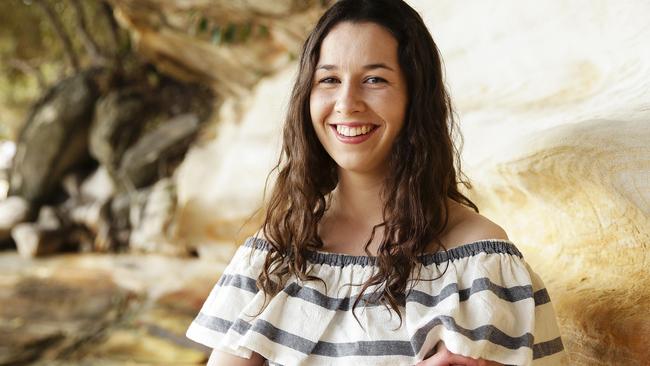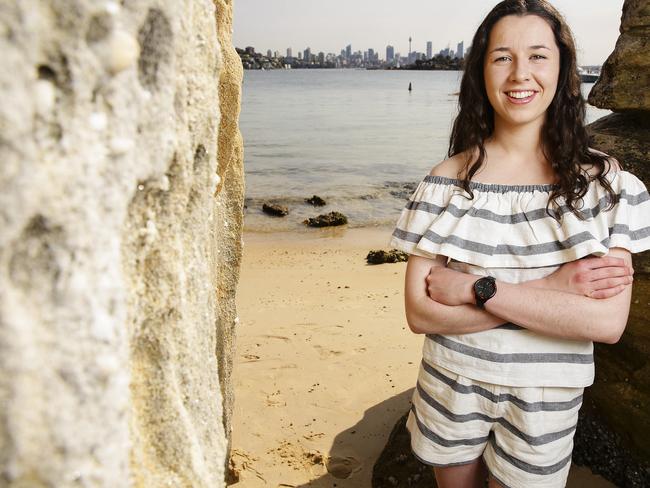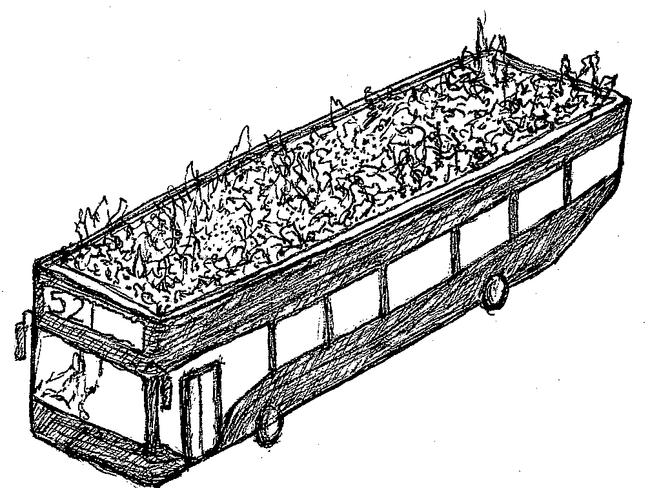Bradfield finalist aims to plant rooftop gardens on buses and enrich the city environment
ELECTRIC buses with live roof gardens irrigated by waste water from air conditioning systems will cool city streets, save energy and enrich the environment, says Lendlease Bradfield Urbanisation Scholarship finalist Eloise Bull.

NSW
Don't miss out on the headlines from NSW. Followed categories will be added to My News.
- A big vision of little homes to tackle housing crisis
- Bradfield finalist’s revolutionary plan for movable homes
ELECTRIC buses with live roof gardens irrigated by waste water from air conditioning systems will cool city streets, save energy and enrich the environment, says Lendlease Bradfield Urbanisation Scholarship finalist Eloise Bull.
The 20-year-old architecture student wants to bring the phytokinetic buses with lightweight roof gardens conceived by landscapers in Spain to Sydney as part of a revolutionary plan to green the harbour city.
While the roof gardens will soak up heat, noise and pollution they will also be a novel way of countering CO2 emissions.
Under Ms Bull’s scheme green roofs and walls will become mandatory for all new residential and commercial developments as well, to provide “urban farms” and minimise heat.
Her plan uses the Parramatta River to create canals and streams running through meadow streetscapes cooling the microclimate and enhancing vegetation.

Ms Bull says a world-class biophilic design _ a deep human need for nature _ is the key to a “living and breathing” Western Sydney. Her visionary idea is to sink roots into subterranean parts of the city with underground carpark gardens featuring reflective canopies and solar skylights.
The finalist who spent seven years of her life living in the lush green London suburb of Wimbledon, says buses take up so much of a city’s prime real estate it makes sense to transform them into part of the green environment.
“The city is much more than its skyscrapers and cultural landmarks,” she says.

“The success of a city should be determined by its effect on the wellbeing of its people.
“Where people’s physical and emotional wellbeing is optimised productivity is at its peak, creativity reaches a crescendo, innovation is intensified, communities are unified and thrive.”
Ms Bull, who is studying at the University of Sydney for a Bachelor of Architecture and Environment, wants a new direction in urban design.
“Our infrastructure, housing, schools and jobs, rather than repelling nature, should embrace it.
“By diminishing the often distinct barrier between the built and the natural we can create a sustainable environment that ensures the success of people and the places they live well into the future.”
Greater Sydney no longer would have to rely on its “greenbelt” of national parks as a major natural attribute. Instead, it had the potential to become a true “greenweb” _ not just through additional open space but through the dense greening of roofs, buildings, streets, transport pathways and homes.

Increased vegetation in Parramatta would help to reduce greenhouse gas emissions through natural processes, minimise urban heat, improve the urban microclimate, contribute to better water management and recycling, increase buildings’ energy efficiency, improve air quality, promote biodiversity and provide effective acoustic insulation.
But Parramatta would just be the starting point as biophilic urban design expanded to Blacktown and Penrith and then filtered through to urban landscapes in between.
Ms Bull says: “It is not simply an attempt to green the cities or develop environmentally sustainable ways of life for the sake of it. It is a strategy to ensure people’s wellbeing.
“The economic benefits to the area also would be considerable. Nature’s ability to reduce stress and improve people’s productivity contributes to developing highly effective workplaces.”
Green roofs and walls from high rise offices to single residential dwellings provide a platform for “urban farms” encouraging locally sourced produce and sustainable, micro-scale agricultural practices.
Handing further urban farm projects over to local schools and community clubs would promote community engagement and social cohesion as well as providing additional employment opportunities.
“At the street level improving Parramatta’s walkability is vital to ensuring a successful biophilic urban design strategy,” Ms Bull says.
“Streets largely designed for vehicles tend to prohibit pedestrian access and encourage dependence on cars and other motor vehicles.
“Counteracting this would involve providing bike lanes along every street, widening pedestrian walkways and carpeting them with turf, gravel and plants.
“This approach makes good use of existing plans for sustainable transport through the city while leaving room for technological advances which may make current motor vehicles and transport systems redundant.”
ends

